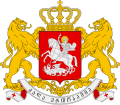
Borjgali (Georgian: ბორჯღალი; also Borjgala or Borjgalo; Borçgali in Laz) is a Georgian symbol of the Sun and eternity.[1][2] The Borjgali is often represented with seven rotating wings over the tree of life which can be used to create various shapes and variations and is considered one of the main symbols of Georgian culture.[3]
Etymology
[edit]The term Borjgali translates to "the flow of time" from Megrelian borj "time" and gal "pass" or "flow". The word is believed to derive from the Megrelian term ბარჩხალი (barchkhali), which means "brilliance" or "glitter." Other scholars believe its origin is from Old Georgian ბურჯი (burji) "time" and "ღალ" (ghal) "holy fruit" or "harvest," together meaning "holy fruit sprouting from time."[4]
Usage
[edit]This pre-Christian symbol was widely used in both western (Colchis) and eastern Georgia (in Georgian architecture's Dedabodzi, "mother-pillar") as part of a Darbazi in the Kura–Araxes culture as a holy symbol.[5] During the medieval period, this symbol was incorporated as a part of Christian symbolism.[citation needed]
Nowadays, the symbol is used in Georgian IDs and passports, as well as on currency and by the Georgian Rugby Union. Georgian rugby team players are called ბორჯღალოსნები (borjgalosnebi), which means "Men bearing Borjgali". It was also used on the naval ensign of Georgia during the late 1990s and early 2000s.[6]
Gallery
[edit]-
Colchian representation of the Borjgali
-
Borjgali on the Cathedral of Oshki
-
Borjgali on a Georgian coin
-
Borjgali on 100 Georgian lari
-
Georgian rugby player with Borjgali on his shorts and shirt
-
Borjgali on Georgian Airways
-
Borjgali in Fereydunshahr
-
Borgali on the former Georgian naval ensign, used during the late 1990s and early 2000s
See also
[edit]- Laz people
- Arevakhach
- Hilarri
- Lauburu
- Triskelion
- Swastika
- Western use of the swastika in the early 20th century
References
[edit]- ^ Evolving Virtual and Computational Paleontology. (2020). (n.p.): Frontiers Media SA. p.131 : "seven-rayed symbol of sun and eternity typical of Georgia"
- ^ Mikaberidze, A. (2015). Historical Dictionary of Georgia. United Kingdom: Rowman & Littlefield Publishers. p.204
- ^ "Georgian National Museum".
- ^ "ბორჯღალას წარმოშობა, ეტიმოლოგია და მნიშვნელობა". Doctrina (in Georgian). 2017-04-20. Retrieved 2025-03-27.
- ^ რატი იონათამიშვილი ”ბორჯღალასა და სვასტიკის გენეზისისთვის” თბ.(2006) [Rati Ionatamishvili, Genesis of the Leopard and the Swastika, Tbilisi, 2006 ]
- ^ Armand du Payrat, CV(R) (2000). Album des pavillons nationaux et des marques distinctives / National flags and distinctive markings (in French and English). Daniel Roudaut (ill.) (8th. ed.). Brest (France): S.H.O.M. (Service Hydrographique et Océanographique de la Marine). p. 238. ISBN 2-11-088247-6. 978-2-11-088247-9.Previous edition: [pie90]
Format: A4 (tall) (279×210 mm)
Further reading
[edit]- Symbol dictionary [1]
- Historical Dictionary of Georgia, Alexander Mikaberidze
- T. Wilson „The swastika, the earliest known symbol and its migrations“ Wosh. 1990
- Transcaucasian Banknotes, Arutiun Airapetian, p. 52








